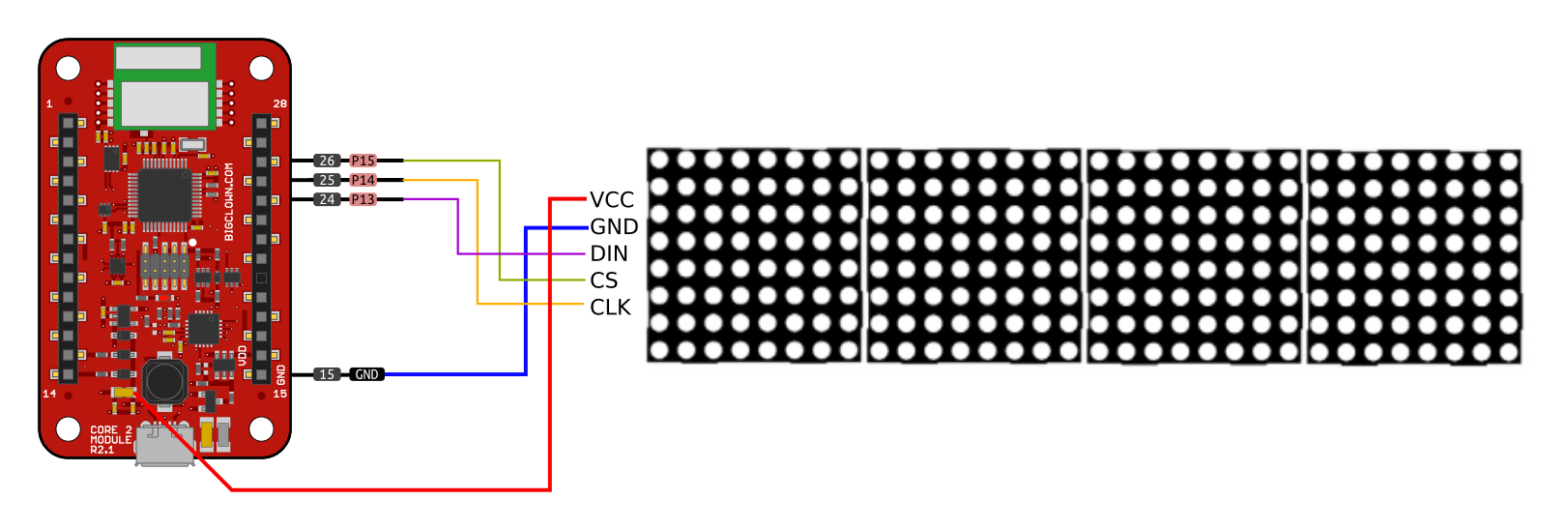Wireless matrix LED display which you can place anwhere in your home. Connect to USB charger or power bank for real "wireless" installation.
You can display messages, temperatures, subscriber count (only for Youtubers with under 6-digit subs), Bitcoins, unread e-mails...
You can also make it bigger in any direction or plane :)
The wireless LED display connects over 868 MHz FSK radio to the Raspberry Pi thanks to Radio Dongle.
Raspberry Pi has pre-installed "bc-raspbian" which is Raspbian with MQTT broker, Node-RED and Radio Gateway Service. You can install these services yourself to your Rpi or any computer. Just follow the documentation.
The hardware is really just the Core Module and the LED Matrix Display. Mechanically connected with plastic spacers.
You will need Male/Female wires to connect these two modules:
The Core Module has only 3V on the VDD pin, so it is necessary to solder the red wire near the input capacitor. On the real images I use older Core Module R1, but the connection diagram is for the current newer one Core Module R2.
Step 2: Flash FirmwareDownload BigClown Playground multiplatform GUI tool to your computer. This tool can flash firmware and also contains other features like MQTT and Node-RED. But we will not use them since the brain of our system will be the Raspberry Pi with bc-raspbian (explained later)
- Connect Core Module to your PC and wait until the FTDI driver is installed
- Run the BigClown Playground
- Download binary or copy the URL of the latest firmware file to the clipboard
- Go to the Firmware tab and choose the downloaded file from the disk or paste URL from clipboard with Ctrl+V
- Choose the correct serial COM port and press "FLASH FIRMWARE" button
- After flashing, the Core Module will turn on red LED for 2 seconds
- After power-up it displays "BigClwn" text on the display
See troubleshooting section or visit BigClown forum if something goes wrong
The Radio Dongle comes pre-flashed but we suggeest to update it to the latest version. Disconnect the Core Module, connect Radio Dongle and flash it with bcf-gateway-usb-dongle firmware
You can close the BigClown Playground. From now you will use the BigClown Hub in your browser that will be running on the Raspberry Pi. However these tools looks similar and it is possible to test steps below just in the Playground and do not use Raspberry Pi.
Step 3: Raspberry Pi set-upDownload and copy the bc-raspbian to the micro SD card. You can also install the services manually on clean Raspbian or run them on any Linux single board computer. Follow this documentation.
After flashing, put the card to the Raspberry Pi, plug-in the Radio Dongle, connect network cable and power cable, boot the Rpi up.
You can connect to the BigClown Hub, open in your browser page.
hub.localin case you used bc-raspbianraspberry.localin case you installed tools on clean Raspbian- By typing IP address or the Raspi
Detailed documentation of this step is in the documentation.
Step 4: PairingFrom here we will use the BigClown Hub in your browser.
You need to pair LED Display Core Module with Radio Dongle:
- Disconnect power from the LED Display Core Module
- Go to the Devices tab and click Start Pairing
- Power on the LED Display Core Module
- The newly paired device will appear in the table
- Click Stop Pairing
Check that you have the same name of the module, it has to be the same because we use that name later in MQTT topics. You can rename the node to the right name.
Now we add the function to control this display. Let's start with something easy like display current time.
Switch to the Functions tab whre the Node-RED is and in the top-right menu select Menu > Import > Clipboard
Copy and paste the text from this gist. Press Import. You will see something like this.
PressDEPLOY in the top-right corner to apply changes. Now the "timestamp" block will fire every second, the Function node "Time" will set current time and output it to the MQTT node.
I've also added intensity buttons, you can set values from 1 to 15.
You can install Openweathermap plugin to the Node-RED and display outside temperature on the display.
You can use this device as a display for snail-mail notification from other tutorial.
Core Module has FTDI chip with virtual serial port. You can use that port and write text on display just over USB cable without wireless communication. How-to: UART.
The Core Module has also button, accelerometer and temperature sensor. You can edit the original source code and extend functionality to trigger some event or flip the display if you turn it upside down.
See also other BigClown projects on Hackster.io or on their website
- Door Sensor project
- Radio Button Project
- Check out other BigClown projects.
- Take a look at the Module Overview.
- Learn about MQTT and BigClown MQTT topics to control LEDs and relays.
- Try other integrations with Grafana, Blynk, IFTTT, Ubidots and others.
- Use your Raspberry PI or other single board computer (SBC) as a server.
- Flash other firmware or write your own firmware for the Core Module.
- Check the Core Module pinouts and add your own buttons, relays and sensors.



















Comments
Please log in or sign up to comment.